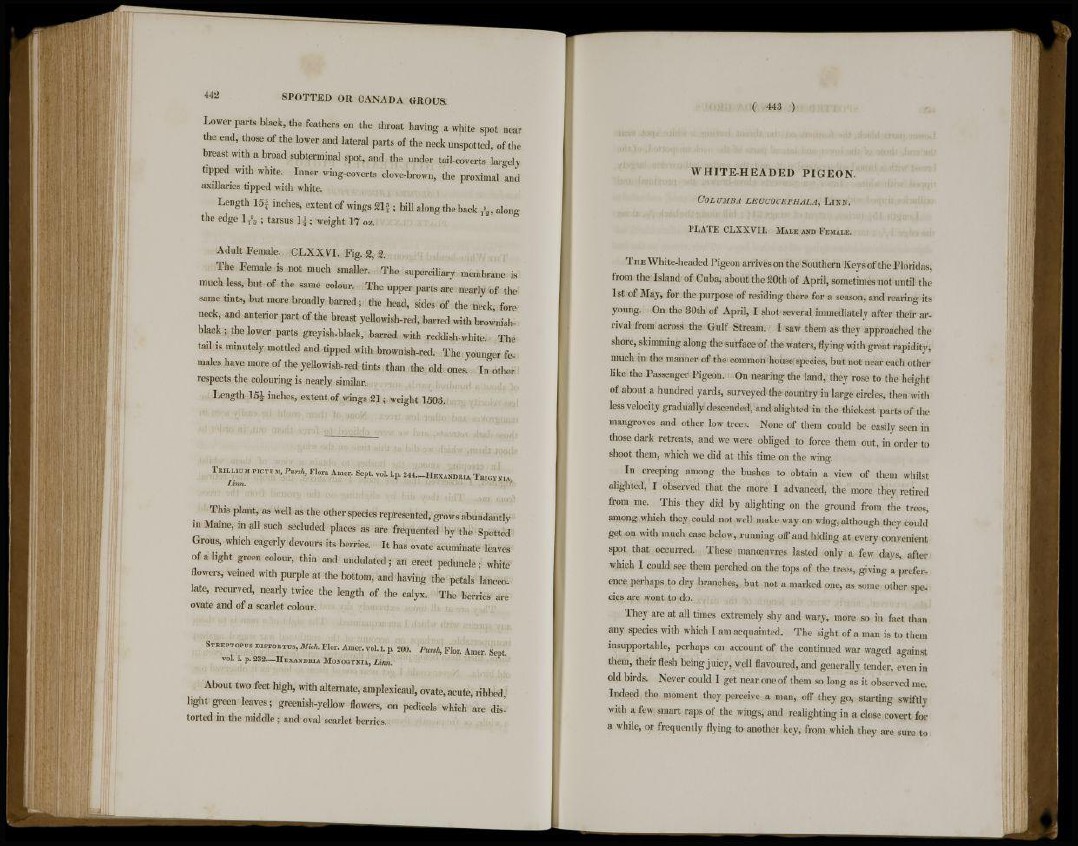
442 S P O T T E D O R C A N A D A GROUS.
Lower parts black, the feathers on the throat having a white spot near
the end, those of the lower and lateral parts of the neck unspotted, of the
breast with a broad subterminal spot, and the under tail-coverts largely
tipped with white. Inner wing-coverts clove-brown, the proximal and
axillaries tipped with white.
Length 15£ inches, extent of wings 21-* ; bill along the back T
s
2 , along
the edge 1T
8
2 ; tarsus 1£; weight 17 oz.
Adult Female. CLXXVI. Fig. 2, 2.
The Female is not much smaller. The superciliary membrane is
much less, but of the same colour. The upper parts are nearly of the
same tints, but more broadly barred; the head, sides of the neck, fore
neck, and anterior part of the breast yellowish-red, barred with brownishblack
; the lower parts greyish-black, barred with reddish-white. The
tail is minutely mottled and tipped with brownish-red. The younger females
have more of the yellowish-red tints than the old ones. In other
respects the colouring is nearly similar.
Length 15^ inches, extent of wings 2 1 ; weight 1503.
TRILLIUM FICTUM, 1'ursh, Flora Amer. Sept. vol. i.p. 244.—HEXANDRIA TIUUYNIA,
Linn.
This plant, as well as the other species represented, grows abundantly
in Maine, in all such secluded places as are frequented by the Spotted
Grous, which eagerly devours its berries. It has ovate acuminate leaves
of a light green colour, thin and undulated; an erect peduncle; white
flowers, veined with purple at the bottom, and having the petals lanceolate,
recurved, nearly twice the length of the calyx. The berries are
ovate and of a scarlet colour.
STREPTOPUS DISTORTUS, Mich. Flor. Amer. vol. i. p. 200. Pursh, Flor. Amer. Sept.
vol. i. p. 232.—HEXANDRIA MONOGYNIA, Linn.
About two feet high, with alternate, amplexicaul, ovate, acute, ribbed,
light green leaves; greenish-yellow flowers, on pedicels which are distorted
in the middle; and oval scarlet berries.
WHITE-HEADED PIGEON.
COLUMBA LEUCOCEPHALA, LlNN.
PLATE CLXXVII. MALE AND FEMALE.
T H E White-headed Pigeon arrives on the Southern Keys of the Floridas,
from the Island of Cuba, about the 20th of April, sometimes not until the
1st of May, for the purpose of residing there for a season, and rearing its
young. On the 30th of April, I shot several immediately after their arrival
from across the Gulf Stream. I saw them as they approached the
shore, skimming along the surface of the waters, flying with great rapidity,
much in the manner of the common house species, but not near each other
like the Passenger Pigeon. On nearing the land, they rose to the height
of about a hundred yards, surveyed the country in large circles, then with
less velocity gradually descended, and alighted in the thickest parts of the
mangroves and other low trees. None of them could be easily seen in
those dark retreats, and we were obliged to force them out, in order to
shoot them, which we did at this time on the wing.
In creeping among the bushes to obtain a view of them whilst
alighted, I observed that the more I advanced, the more they retired
from me. This they did by alighting on the ground from the trees,
among which they could not well make way on wing, although they could
get on with much ease below, running oft' and hiding at every convenient
spot that occurred. These manceuvres lasted only a few days, after
which I could see them perched on the tops of the trees, giving a preference
perhaps to dry branches, but not a marked one, as some other species
are wont to do.
They are at all times extremely shy and wary, more so in fact than
any species with which I am acquainted. The sight of a man is to them
insupportable, perhaps on account of the continued war waged against
them, their flesh being juicy, well flavoured, and generally tender, even in
old birds. Never could I get near one of them so long as it observed me.
Indeed the moment they perceive a man, off they go, starting swiftly
with a few smart raps of the wings, and realighting in a close covert for
a while, or frequently flying to another key, from which they are sure to